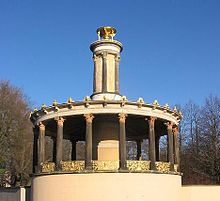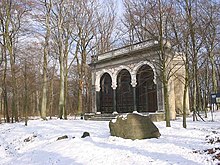Carl of Prussia

Prince Friedrich Carl Alexander of Prussia (born June 29, 1801 in Charlottenburg Palace near Berlin ; † January 21, 1883 in Berlin) was the third son of King Friedrich Wilhelm III. and Queen Luise .
Life

Carl was described by his mother, who had already given birth to his siblings Friedrich Wilhelm (1795–1861), Wilhelm (1798–1888 as Kaiser) and Charlotte (1798–1860 as Tsarina Alexandra Fjodorovna), as "the most beautiful [of their] children" . After Carl, the siblings Alexandrine (1803–1892), Luise (1808–1870) and Albrecht (1809–1872) were born. In 1811, Carl joined the army at the age of 10 and received the rank of Second Lieutenant in the Guard Regiment . His older sister Charlotte looked after him even after she married the future Tsar Nicholas I of Russia in 1817 . Carl was present at the coronation of his sister as Tsarina Alexandra Feodorovna in Moscow in 1825 and he often accompanied her on trips even in old age. After he was confirmed , Carl became a voting member of the Prussian State Council founded in 1817 in 1819 .
In 1820 he began his active military career as a major in the 1st Guards Regiment on foot . As a colonel , he took over the 12th Infantry Regiment and the Imperial Russian Infantry Regiment Liebau in 1822 . On March 30, 1824 he was appointed major general. On January 17, 1830, Carl became commander of the 2nd Guard Division , and on March 30, 1832, he was promoted to lieutenant general . On March 30, 1836, he became the commanding general of the IV Army Corps . After the father Friedrich Wilhelm III. had died and the government was now taken over by his brother Friedrich Wilhelm IV. , Carl achieved the rank of general of the infantry on September 23, 1844 and in March 1848 became inspector of the 2nd Army Department. On March 30, 1854, he was promoted to General Feldzeugmeister and Chief of the Prussian Artillery. In this position, Carl introduced rifled gun barrels instead of the previous smooth barrels.
In addition, he often traveled to Russia to see his favorite sister Charlotte, wife of Tsar Nicholas I. During the revolution in 1848 , Carl stayed in Berlin and made his palace available for citizens' meetings. In addition, he regularly took part in the meetings of the State Council and traveled several times abroad on a diplomatic mission for Friedrich Wilhelm IV. After the death of his brother Friedrich Wilhelm, his second brother took over the government as King Wilhelm I.
From 1864 to 1866, Carl served as governor of Mainz . In 1866 he received the order Pour le Mérite from Wilhelm I for proving the artillery led by Carl in the German War . On August 25, 1878, the Dutch King Wilhelm III. him the Commander's Cross of the Military Wilhelms Order . From June 16, 1871, Carl was chief of the Schleswig-Holstein Uhlan Regiment No. 15 and, from January 1, 1873, also chief of the 3rd Guards Grenadier Landwehr Regiment. Despite all honors, Carl could not make friends with the new circumstances after his brother Wilhelm came to power.
His grave is in the Church of St. Peter and Paul in Berlin-Wannsee .
In 1827, Prince Carl gave its name to Karlplatz in Berlin-Mitte .
Even the Karlsplatz in Berlin light field was named after him from 1895 to 1934. A historicizing street sign still reminds of the former name of the square after Prince Carl.
Buildings and art collections


Through Heinrich von Minutoli , a historian and archaeologist , Carl began to put together a collection of ancient works of art. His historical interest went so far that he had the floor of the tea pavilion "Little Curiosity" in the park of Glienicke covered with antique mosaics from Carthage . He traveled to Italy many times for his collections.
In 1820, before his expedition to Egypt, Minutoli bequeathed the Goslarer Kaiserstuhl, acquired in 1815, to him . In 1824 the prince bought a country house in what is now the Klein-Glienicke landscape park , which Schinkel rebuilt as Glienicke Castle by 1826 and built a casino and the “ Little Curiosity ”. In 1828 the Glienicker Jägerhof was inaugurated.
From 1829 Carl took possession of his winter residence, the Palais Prinz Carl in Berlin at Wilhelmplatz No. 8–9, which he also had Schinkel remodeled.
In 1835 the rotunda “ Great Curiosity ” was built and the park in Glienicke was consistently expanded in the following years.
In 1859 Carl bought the Glienicke hunting lodge for his son, Prince Friedrich Karl .
In memory of his favorite sister Charlotte (Alexandra Fjodorowna) who died in 1860, Carl had the Loggia Alexandra built on the Böttcherberg in 1869 .
In 1874 Glienicke Castle celebrated its 50th anniversary. Princess Marie died in 1877 at the age of 69. Prince Carl then had a crypt built under the church of St. Peter and Paul in Wannsee near the Pfaueninsel , where he was buried next to Princess Marie on the night of January 24th to 25th, 1883.
Order of St. John
At the request of Friedrich Wilhelm IV , the Order of St. John was restored in 1852/53 and Prince Carl was elected Lord Master . The re-establishment took place in the Palais Prinz Carl on Wilhelmplatz.
In 1863, Carl was involved with the Order of St. John in the activities that led to the establishment of the International Committee of the Red Cross . Carl appointed Prince Heinrich XIII as the commissioner for the establishment of an organization for the voluntary care and care of war wounded. Reuss. In Berlin on February 17, 1864 the "Association for the Care of Wounded and Sick Warriors in the Field" was founded, headed by Prince Reuss. This association was the immediate forerunner of the German Red Cross .
On his death, Prince Carl bequeathed the Order of St. John one million gold marks . From the interest on this property, the order was able to maintain an infirmary for workers, from which today's Johanniter retirement home in Lichterfelde developed.
In honor of Carl, the Order of St. John donated a cast iron plaque for St. Peter and Paul in 1981 .
Marriage and offspring

On May 26, 1827, Prince Carl married Princess Marie (1808–1877), daughter of Hereditary Grand Duke Carl Friedrich of Saxe-Weimar-Eisenach, in Charlottenburg near Berlin . The marriage had three children:
- Friedrich Karl von Preußen (1828–1885) ⚭ 1854 Maria Anna von Anhalt-Dessau (1837–1906), daughter of Leopold IV. Von Anhalt-Dessau
-
Marie Luise Anna von Prussia (1829–1901) ⚭ 1854–1861 Landgrave Alexis von Hessen-Philippsthal-Barchfeld (1829–1905)
She acquired Montfort Castle in 1873 and used it as a summer residence on Lake Constance until her death, especially in summer . - Marie Anna Friederike von Prussia (1836–1918) ⚭ 1853 Landgrave Friedrich Wilhelm von Hessen-Rumpenheim (1820–1884)
literature
- Wilhelm Moritz Freiherr von Bissing: His ideal was the absolutely governed state. Prince Carl of Prussia and the Berlin court. In: Der Bär von Berlin (Yearbook of the Association for the History of Berlin ), Volume 25, Berlin 1976.
- Klaus-Werner Haupt: Prince Carl of Prussia and the dream of Italy . In: Occident & Orient. The fascination of the Orient in the long 19th century. Weimarer Verlagsgesellschaft / Imprint of the publishing house Römerweg Wiesbaden 2015, pp. 103–115. ISBN 978-3-7374-0220-0
- Mallow Countess Rothkirch: Prince Carl of Prussia. Knower and protector of the beautiful. 1801-1883. Biblio-Verlag, Osnabrück 1981.
- Kurt von Priesdorff : Soldier leadership . Volume 4. Hanseatische Verlagsanstalt, undated [Hamburg], undated [1937], DNB 367632799 , pp. 468-471, no. 1395.
- Gustav von Glasenapp : Military Biographies of the Officer Corps of the Prussian Army. Berlin 1868, p. 8, Textarchiv - Internet Archive
Web links
- Literature by and about Carl von Prussia in the catalog of the German National Library
- Works by and about Carl von Prussia in the German Digital Library
- Search for "Carl von Preußen" in the SPK digital portal of the Prussian Cultural Heritage Foundation
Individual evidence
- ↑ Karlplatz . In: Street name lexicon of the Luisenstädtischer Bildungsverein
- ^ Harry Nehls: Italy in the Mark - To the history of the Glienicker Antikensammlung ( writings of the Association for the History of Berlin , Issue 63). Westkreuz, Berlin / Bonn 1987
| predecessor | Office | successor |
|---|---|---|
|
August Ferdinand of Prussia until it was repealed in 1811 |
Master of the Balley Brandenburg of the Order of St. John 1853–1883 |
Albrecht of Prussia |
| personal data | |
|---|---|
| SURNAME | Carl of Prussia |
| ALTERNATIVE NAMES | Charles of Prussia; Friedrich Carl Alexander of Prussia |
| BRIEF DESCRIPTION | German prince, son of Friedrich Wilhelm III. and Queen Luise |
| DATE OF BIRTH | June 29, 1801 |
| PLACE OF BIRTH | Berlin |
| DATE OF DEATH | January 21, 1883 |
| Place of death | Berlin |

